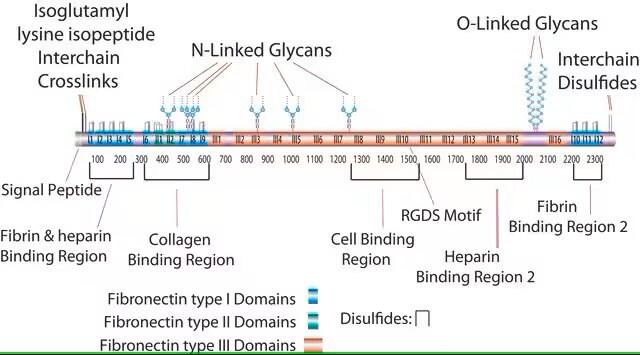10838039001
Roche
Fibronectina
from human plasma
Sinónimos:
Fibronectin
About This Item
Productos recomendados
origen biológico
human plasma
Nivel de calidad
esterilidad
non-sterile; 0.2 μm filtered
Análisis
95% (SDS-PAGE)
formulario
lyophilized (clear, colorless solution after reconstitution)
mol peso
440 kDa
envase
pkg of 5 mg
fabricante / nombre comercial
Roche
condiciones de almacenamiento
avoid repeated freeze/thaw cycles
técnicas
cell culture | mammalian: suitable
Nº de acceso UniProt
temp. de almacenamiento
2-8°C
Información sobre el gen
human ... FN1(2335)
¿Está buscando productos similares? Visita Guía de comparación de productos
Descripción general
Especificidad
Aplicación
Método de análisis
Forma física
Nota de preparación
5 μg/cm2 for the coating of cell culture vessels
Storage conditions (working solution): -15 to -25 °C
The reconstituted solution is stable at -15 to -25 °C.
Note: Store the reconstituted solution in aliquots at -15 to -25 °C.
Avoid repeated freezing and thawing.
Reconstitución
Upon reconstitution, the solution may contain a small amount of insoluble aggregated material. These aggregates are a phenomenon inherent to fibronectin and do not influence product performance.
Otras notas
Cláusula de descargo de responsabilidad
Código de clase de almacenamiento
11 - Combustible Solids
Clase de riesgo para el agua (WGK)
WGK 1
Punto de inflamabilidad (°F)
does not flash
Punto de inflamabilidad (°C)
does not flash
Certificados de análisis (COA)
Busque Certificados de análisis (COA) introduciendo el número de lote del producto. Los números de lote se encuentran en la etiqueta del producto después de las palabras «Lot» o «Batch»
¿Ya tiene este producto?
Encuentre la documentación para los productos que ha comprado recientemente en la Biblioteca de documentos.
Los clientes también vieron
Artículos
The extracellular matrix (ECM) is secreted by cells and surrounds them in tissues.
3D cell culture overview. Learn about 2D vs 3D cell culture, advantages of 3D cell culture, and techniques available to develop 3D cell models
Extracellular matrix proteins such as laminin, collagen, and fibronectin can be used as cell attachment substrates in cell culture.
Protocolos
Dilute fibronectin to the desired concentration. Optimum conditions for attachment are dependent on cell type and application. The typical coating concentration is 1 – 5 ug/cm2.Fibronectin coating protocol, products, and FAQs.
Nuestro equipo de científicos tiene experiencia en todas las áreas de investigación: Ciencias de la vida, Ciencia de los materiales, Síntesis química, Cromatografía, Analítica y muchas otras.
Póngase en contacto con el Servicio técnico






